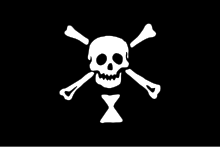Emanuel Wynne
Emanuel Wynne (also Emmanuel Wynne and Emanuel Wynn ) was a Breton pirate who operated in the North Atlantic and the Caribbean in the late 17th and early 18th centuries . He is believed to be the first to use a flag with a skull and crossbones .
First user of the Jolly Roger
Wynne's flag also showed an hourglass under the skull and crossbones , a symbol also popular among pirates, which was intended to signal to the loot ship that only timely surrender could avert an otherwise certain death.
Wynne initially operated off the coast of the British colony of Carolina (now North Carolina and South Carolina ) in North America, where he ambushed British ships, but then switched to the more lucrative business in the Caribbean, where he was also able to raise Spanish ships.
On July 18, 1700, according to official British Admiralty reports, Captain John Cranby and his frigate HMS Poole (built in 1696 by Nye in East Cowes, 32 guns) discovered Wynne's ship Adventure near the Cape Verde island of Brava . Cranby chased the pirate for several days, but Wynne escaped when two other pirate ships ( La Foudre under Lussan and Treasure under Moore) appeared to assist him. Cranby's report is, as far as is known, the first to mention a flag with a skull and crossbones on a pirate ship: "a black flag with crossbones, a skull and an hourglass" (" a sable ensign with cross bones, a death's head, and an hour glass ”). Wynne is therefore considered to be the first pirate to flag the shape of the Jolly Roger that is known today .
Even Henry Every , who in 1696 sailed for the last time, is called the first bearer of a skull and crossbones flag.
Movie
Wynne's flag was shown in the American pirate film The Pirate Bride (original title: Cutthroat Island ) from 1995.
Individual evidence
- ↑ Document flag Emanuel Wynne
- ↑ In some reports this meeting is moved to the vicinity of Santiago de Cuba .
literature
- Peter Earle: The Pirate Wars. St. Martin's Griffin and Thomas Dunne Books, New York 2006, ISBN 978-0-312-33580-9 , pp. 153-154.
- Angus Konstam: Pirates 1660-1730. Osprey, Botley 1998, ISBN 978-1-85532-706-1 .
- Terry Breverton: The Pirate Dictionary. Pelican Publishing Company, Gretna LA 2004, ISBN 978-1-58980-243-8 , p. 119.
Web links
- Pirate flags on bonaventure.org.uk
| personal data | |
|---|---|
| SURNAME | Wynne, Emanuel |
| ALTERNATIVE NAMES | Wynn, Emanuel |
| BRIEF DESCRIPTION | Breton pirate |
| DATE OF BIRTH | 17th century |
| DATE OF DEATH | 18th century |
